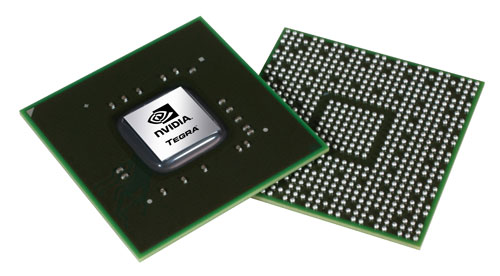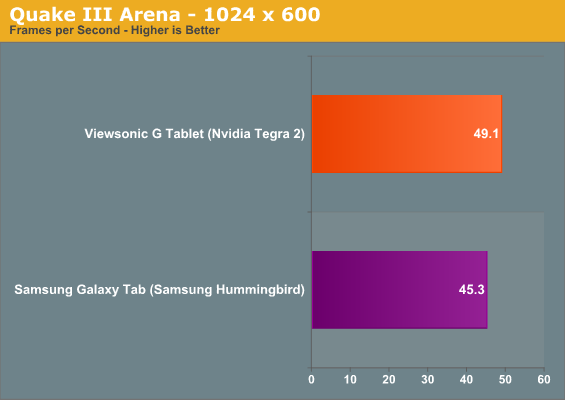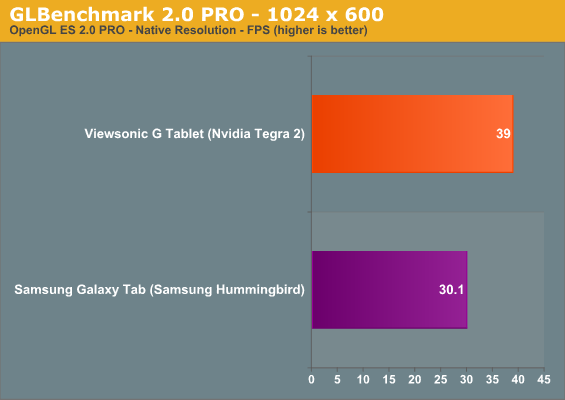Nvidia Tegra 2 - Graphics Performance Update
by Vivek Gowri on December 20, 2010 11:00 PM EST

So I have a confession to make. Before we posted our Tegra 2 performance preview, I ran the Quake 3 demo on the Viewsonic G Tablet and the Samsung Galaxy Tab three times each. I ended up with 49.0, 48.2 and 49.9 fps on the Viewsonic, and 31.9, 32.2, and 32.1 fps on the Galaxy Tab. Run the averages, and you get 49.1 fps for the Viewsonic and 32.1 fps for the Galaxy. Based on some input from Imagination and other Galaxy Tab users, we decided to retest the Galaxy Tab, since our results were a good bit lower than what they were reporting.
And on re-running the Quake 3 benchmark, I got results in the 44.9 - 46.0 range. I ran it over 50 times trying to replicate the previous scores, but under no conditions (settings, background applications, etc) could I get anywhere near my previous result. I know for a fact that the settings were all correct and that there were no previously running applications, so I really have no idea why I got a framerate that low, much less why it was repeatable.
In addition to retesting Quake 3 on the Galaxy Tab, I also ran both slates through GLBenchmark 2.0, which we recently added to our benchmark suite. The combination of the two gave me enough reason to write up an update to our Tegra 2 performance preview from two weeks ago. I was also planning to compare Quadrant’s 3D graphics score, but I was unable to get the SlideME store working on the Viewsonic to download Quadrant Professional.
So, let’s get to it. With the revised Quake 3 benchmarks, Tegra 2 has a slight 10% lead over the SGX 540, bringing it more in line with what we expected. Looking at our GLBenchmark 2.0 results, we can see that Tegra 2 has the lead here as well, though by a slightly larger margin. In GLBenchmark Pro, the Tegra 2 has a 30% lead over the Hummingbird, while in the more-demanding Egypt benchmark, the gap shrinks to 20.4%.



So while the performance difference isn’t nearly as dramatic as we originally thought, most of what we said before still holds true. It looks like Tegra 2 has the potential to be the best SoC for Android gaming, making it a really attractive platform for tablets. With all the rumours flying around about Google making Tegra 2 the reference platform for Honeycomb-based tablets, apparently we’re not the only ones who think so. The question is how well will it handle existing 3D content that's likely optimized for Qualcomm and Imagination Technologies GPUs.
We’ll take a more in-depth look at Tegra 2’s performance as well as power consumption in our full review later this month, and hopefully by that time we can give you the Quadrant benchmarks as well. But for now, we can say that Tegra 2 is the most powerful SoC on the market at present and makes for a very capable tablet platform.










27 Comments
View All Comments
synaesthetic - Tuesday, December 21, 2010 - link
These tests are much more GPU than CPU, so it's not really going to show the benefit of the Tegra's dual-core Cortex A9 over the single-core Cortex A8 in the Hummingbird SoC.Alexvrb - Tuesday, December 21, 2010 - link
We don't know that for sure. I'd like to see some results of the Hummingbird with the CPU overclocked a good bit.VivekGowri - Tuesday, December 21, 2010 - link
As the others said, these are purely graphics benchmarks, so it's looking more at Nvidia's GeForce ULP versus the PowerVR SGX 540 that Samsung is using in their Hummingbird chips. For the CPU benchmarks, read the original article, it'll have a more in depth comparison of the dual core Cortex A9 versus the Cortex A8 and Snapdragon.The difference in the Galaxy Tab's performance wasn't due to on AC/on battery - I tried that and didn't see a difference in performance either way during my retest. It's really perplexing, I literally tried everything and couldn't get anything approaching my old result.
The Samsung + Tegra 2 thing sounds weird to me. I'm not too sure of what the point is - maybe they hit some kind of development snag in Orion so they're going to release the 2nd gen Galaxy Tab with Tegra 2 just as a stopgap? I can't honestly see Samsung going with another chipmaker's SoC long term when they have a very parallel, potentially superior, chip already in the development stage.
sarge78 - Tuesday, December 21, 2010 - link
Could be a Apple/Intrinsity thing?mczak - Tuesday, December 21, 2010 - link
While it's true these benchmarks shouldn't really be cpu dependent, they are most likely definitely affected by memory bandwidth. Tegra 2 chip could have an advantage here - I believe Tegra 2 is using (32bit) lpddr2 whereas Hummingbird is (32bit) lpddr1 (not sure it's hard to get definitive answers on that!) That's not to say it's an unfair advantage, but next year Cortex A9 designs featuring SGX540 will also use lpddr2 (and actually the ti omap 4430 supports 2x32bit lpddr2). Now SGX chips are not really heavily dependent on bandwidth (thanks to the tile based deferred rendering), but this could easily make a big difference I think, given that we're talking very low bandwidth with 32bit lpddr1.dagamer34 - Wednesday, December 22, 2010 - link
SImple reason. Most people care about product branding than hardware chips. It doesn't matter that a Galaxy Tab 2 will be build with a Tegra 2 SoC, because the Galaxy Tab 3 is likely to have Orion in it. But because Tegra 2 is the official reference platform for Honeycomb, I doubt they'd have enough time to finish both the Orion SoC and Honeycomb support for the SoC without a few months passing by with nothing new on the market.Favoring your own chips is not always a wise decision if it gets in the way of marketing.
ltcommanderdata - Tuesday, December 21, 2010 - link
In terms of how well existing games optimized for PowerVR GPUs work on Tegra, does Tegra support the GL_IMG_texture_compression_pvrtc extension? I believe that's the primary Imagination developed OpenGL ES extension and is very commonly used in iOS games, which being the tier-1 mobile platform means most mobile games, and makes sense to use given it's bandwidth saving benefits. For example, even for porting old games like Doom to iOS, John Carmack converts textures to PVRTC as much as possible. Since Imagination published it as an open extension it'll be interesting to see if nVidia supports it.R3MF - Tuesday, December 21, 2010 - link
the real test will arrive along with the new TI SoC sporting the PowerVR SGX540 GPU!argosreality - Tuesday, December 21, 2010 - link
Interesting results its just sad that you cant get the Viewsonic tablet through staples anymore. They were pulled for hardware issuesScreenr - Tuesday, December 21, 2010 - link
There's actually nothing wrong with the hardware (other than a screen with bad viewing angles from the edge, which doesn't really bug me). Staples posted a "manufacturing defect" because the default software interface sucks big time. With about 15 minutes of work (basically putting a rom on a memory card or via USB to the internal drive), you can have this thing running smoothly with a more default Android 2.2 interface, and it runs beautifully, whomping my ipad in overall performance.The ipad is a smoother customer experience out of the box.
Viewsonic and Staples are squabbling over this, and it will clearly hurt Viewsonic's sales, but quite a few people are using this device quite well via xda forums and androidforums.